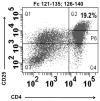The immunomodulatory effects of intravenous immunoglobulin therapy in Kawasaki disease
- PMID: 26099344
- PMCID: PMC4985263
- DOI: 10.1586/1744666X.2015.1044980
The immunomodulatory effects of intravenous immunoglobulin therapy in Kawasaki disease
Abstract
The introduction of intravenous immunoglobulin (IVIG) for modulation of inflammation in acute Kawasaki disease was a great therapeutic triumph. However, three decades later, the mechanisms underlying immune regulation by IVIG are only beginning to be revealed. Stimulation of an immature myeloid population of dendritic cells that secretes IL-10 and the elucidation of Fc-specific natural regulatory T cells provide insights into the mechanisms of IVIG. Other potential mechanisms include provision of agent-specific neutralizing antibody, anti-idiotype and anti-cytokine antibodies, blockade of activating Fcγ receptors and stimulation of the inhibitory FcγRIIb receptor. New initiatives must seek to understand the mechanisms of IVIG in order to replace it one day with more affordable and more targeted therapies.
Keywords: Kawasaki disease; acquired heart disease; coronary artery aneurysms; immune regulation; myocardial infarction; pediatric vasculitis.
Figures
References
-
- Newburger JW, Takahashi M, Gerber MA, et al. Diagnosis, treatment and long term management of Kawaski disease: a statement for helath professionals from the Committee for Rheumatic Fever, Endocarditis and Kawaski Disease, Council on Cardiovascular Diseases in the Young, American Heart Association. Circulation. 2004;110:2747–2771. - PubMed
-
- Kawasaki T, Kosaki F, Okawa S, et al. A new infantile acute febrile mucocutaneous lymph node syndrome (MLNS) prevailing in Japan. Pediatrics. 1974;54(3):271–276. - PubMed
-
- Burns JC, Shike H, Gordon JB, et al. Sequelae of Kawasaki disease in adolescents and young adults. J Am Coll Cardiol. 1996;28:253–257. - PubMed
-
- Imbach P, Barandun S, d’Apuzzo V. High-dose intravenous gammaglobulin for idiopathic thrombocytopenic purpura in childhood. Lancet. 1981;1:1228–1231. - PubMed
-
- Furusho K, Sato K, Soeda T, et al. High-dose intravenous gammaglobulin for Kawasaki disease. Lancet. 1983;2(8363):1359. - PubMed
Publication types
MeSH terms
Substances
Grants and funding
LinkOut - more resources
Full Text Sources
Medical
Molecular Biology Databases

